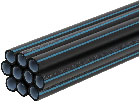
Product Standard : MS 1058-2 : 2005 & ISO 4427-2 : 2007
High Density Polyethylene (HDPE) Pipe has been the dominant and preferred piping for water pressure pipes application due to its advantages in flexibility, easy installation, corrosion & chemical resistance, durability, high performance and in terms of economical aspects. HDPE pipes have the widest ranges among other piping materials. The introduction of PE-100 material enables the pipes to be produced thinner, yet maintaining the pressure ratings. Hence, the pipes become lighter, increased flow rate and with further cost saving.
Advantages of PE100 vs PE80
High Density Polyethylene (HDPE) Pipe has been the dominant and preferred piping for water pressure pipes application due to its advantages in flexibility, easy installation, corrosion & chemical resistance, durability, high performance and in terms of economical aspects. HDPE pipes have the widest ranges among other piping materials. The introduction of PE-100 material enables the pipes to be produced thinner, yet maintaining the pressure ratings. Hence, the pipes become lighter, increased flow rate and with further cost saving.
- PE100 materials can withstand a minimum circumferential stress (or hoop stress) of 10MPa for 50 years at 20˚C. This compares with a performance of 8MPa for 50 years at 20˚C for PE80 materials. The higher long term creep resistance of PE100 materials translates into higher operating pressures at the same wall thickness, or alternatively, thinner walled pipe at the same operating pressure, offering greater hydraulic capacity than PE80 materials.
- PE100 materials have improved notch resistance compared with PE80 resins. This means they are even less sensitive to surface damage during laying.
- Pipes made from PE100 have improved resistance to rapid crack growth. This means that if a fast crack begins to grow in a PE100 pipe, it will be arrested after propagating only a short distance.
The products are tested and conformed to the stringent standard requirements and performance
specifications, thus it ensures that the product quality is consistently maintained.
Performance Specifications
| Items | Units | Characteristic | Parameter | |
|---|---|---|---|---|
| PE-80 | PE-100 | |||
| Hydrostatic strength | MPa |
20˚C (100h) : No break & leakage |
9.0 |
12.4 |
| Elongation at break | % | ≥ 350 | ||
| Thermal stability (Oxidation induction time) |
min | > 20 | 200˚C | |
| Melt flow rate (MFR) | g/10min | Changes of MFR by processing < 25% | 190˚C, 5kgs | |
| Longitudinal reversion | % | ≤ 3 | 110˚C | |
PE100 Dimensions
| Nominal (mm) |
Outer diameter (mm) |
Wall thickness (mm) PN12.5 (SDR13.6) |
Wall thickness (mm) PN16 (SDR11) |
|---|---|---|---|
| Size | Min Max | Min Max | Min Max |
| 20 | 20.0 20.3 | - - | 2.0 2.3 |
| 25 | 25.0 25.3 | 2.0 2.3 | 2.3 2.7 |
| 32 | 32.0 32.3 | 2.4 2.8 | 3.0 3.4 |
| 40 | 40.0 40.4 | 3.0 3.5 | 3.7 4.2 |
| 50 | 50.0 50.4 | 3.7 4.2 | 4.6 5.2 |
| 63 | 63.0 63.4 | 4.7 5.3 | 5.8 6.5 |
| 75 | 75.0 75.5 | 5.6 6.3 | 6.8 7.6 |
| 90 | 90.0 90.6 | 6.7 7.5 | 8.2 9.2 |
| 110 | 110.0 110.7 | 8.1 9.1 | 10.0 11.1 |
| 125 | 125.0 125.8 | 9.2 10.3 | 11.4 12.7 |
| 140 | 140.0 140.9 | 10.3 11.5 | 12.7 14.1 |
| 160 | 160.0 161.0 | 11.8 13.1 | 14.6 16.2 |
| 180 | 180.0 181.0 | 13.3 14.8 | 16.4 18.2 |
| 200 | 200.0 201.2 | 14.7 16.3 | 18.2 20.2 |
| 225 | 225.0 226.4 | 16.6 18.4 | 20.5 22.7 |
| 250 | 250.0 251.5 | 18.4 20.4 | 22.7 25.1 |
| 280 | 280.0 281.7 | 20.6 22.8 | 25.4 28.1 |
| 315 | 315.0 316.9 | 23.2 25.7 | 28.6 31.6 |
Product List
| PE100 PN12.5 (5m) | PE100 PN16 (5m) | ||
 |
 |
